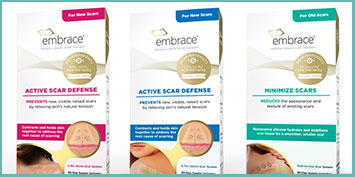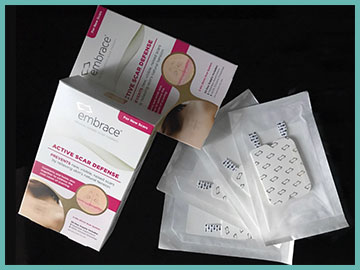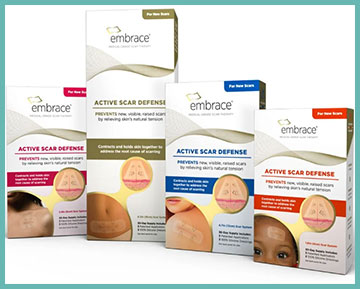I wanted to believe in Embrace Scar Therapy. After my surgery, I was desperate for a product that could make my scars fade into a whisper of their former selves.
The promise of a thinner, lighter scar was tempting, and the science behind it sounded convincing. But after my experience and digging into others’ stories, I can’t recommend Embrace.
It’s not the miracle it claims to be, and for some, it’s caused more harm than good. Let me take you through my journey, the good, the bad, and why you might want to look elsewhere.
My Experience with Embrace Scar Therapy
A few months ago, I had abdominal surgery that left me with a prominent scar across my lower abdomen. It was red, raised, and a constant reminder of the procedure. My surgeon suggested Embrace Scar Therapy, touting its FDA clearance and clinical trials.

I was intrigued by the idea of a silicone sheet that could reduce tension on the scar, supposedly preventing it from widening or becoming hypertrophic. So, I ordered a 60-day supply, excited to see my scar transform into a “pencil-thin line,” as the website promised.
Applying the first strip was a bit of a hassle. The applicator is designed to stretch the silicone sheet before you place it over the scar, but it felt like wrestling with a sticky piece of plastic. I followed the instructions to the letter: clean the area, let it dry, position the strip, and press for 60 seconds.
It stuck, and I felt a slight pulling sensation, which I assumed was the “tension relief” at work. For the first couple of days, I was optimistic. The strip stayed in place, and I could shower without it budging—a big plus since I wasn’t keen on daily reapplications.
But by day four, the edges started peeling. Air pockets formed, and the strip looked like it was barely hanging on. I tried reapplying it, but it wouldn’t stick as well. By day seven, it was off completely. I was frustrated but chalked it up to user error.
I applied a second strip with extra care, even watching the YouTube tutorial again. Same story—peeling edges, air bubbles, and it fell off in five days. Worse, my skin was red and irritated where the adhesive had been. I started to worry about the “medical-grade adhesive” that was supposed to be gentle.
Then came the real kicker. After removing the second strip, I noticed small blisters forming along the scar. They were painful, and the skin around them looked raw.
I stopped using Embrace immediately and consulted my dermatologist, who advised me to let my skin breathe and avoid adhesives for a while. The blisters healed, but they left faint marks that, ironically, made my scar area look worse. I was gutted. I’d spent over $100 on this product, hoping for a smoother scar, and ended up with new skin issues.
I scoured online reviews to see if I was alone. Turns out, I wasn’t. Many users reported similar problems—strips falling off, skin irritation, even severe reactions like skin tearing. One review described a “bloody, horrifying mess” after removal, which sent chills down my spine.
While some users raved about flatter scars, the negative experiences were too common to ignore. My scar didn’t improve noticeably during the two weeks I used Embrace, and the irritation set me back in my healing process. That’s when I decided to explore other options and share my story with you.
Pros Of Embrace Scar Therapy
Despite my disappointment, Embrace Scar Therapy does have some strengths. It’s not all bad, and I want to give credit where it’s due. Here’s what I found promising about the product.
FDA Clearance and Clinical Backing
Embrace is FDA-cleared, which gave me confidence at first. It’s not just another gimmicky cream—it’s backed by clinical trials, particularly for high-tension scars like those from abdominoplasties. Studies, like the one published in Plastic and Reconstructive Surgery, showed that Embrace-treated scars had better visual analogue scale scores compared to standard care. The science behind mechanomodulation—reducing tension on the scar to minimize collagen buildup—makes sense and sets it apart from traditional silicone sheets.

Tension Relief Feels Real
When the strip was actually sticking, I could feel it holding my scar together. It’s designed to offload mechanical stress, which is a major cause of wide or raised scars. For the few days it stayed on, I noticed less pulling when I moved, which was a relief after feeling my skin tug with every twist or bend. Some users, especially those with C-sections or breast surgeries, reported that this tension relief made their scars feel less tight and uncomfortable.
Water-Resistant Design
One of Embrace’s selling points is its water-resistant nature. You can shower or exercise without worrying about the strip falling off immediately. This was a big win for me, as I didn’t want to baby my scar or avoid my daily routine. The silicone sheet is also breathable, so it didn’t feel like my skin was suffocating, even if it didn’t stay on as long as promised.
No Daily Maintenance
Unlike creams or gels that require multiple applications a day, Embrace is low-maintenance. Each strip is supposed to last 7-10 days, which is great for those of us who don’t want to fuss with a daily regimen. When it worked, I appreciated not having to think about my scar constantly. It’s a set-it-and-forget-it approach, at least in theory.
Positive Anecdotes from Users
Some people swear by Embrace. I read reviews from patients who said their scars became “pencil-thin” or “barely noticeable” after 60 days. One user with a tummy tuck scar raved about how flat and smooth their scar became, even compared to friends who didn’t use it. These success stories suggest that when it works, it can deliver impressive results, especially for fresh scars under six months old.
Cons Of Embrace Scar Therapy
Now, let’s talk about the downsides. My experience wasn’t unique, and the cons of Embrace Scar Therapy are significant enough to make you think twice.
Adhesive Issues and Poor Durability
The biggest complaint I—and many others—have is that the strips don’t stay on. Despite claims of lasting 7-10 days, mine peeled off in as little as one day. Reviews on Amazon echo this: users reported edges lifting, air pockets forming, and strips falling off completely. One person even said their plastic surgeon noted that the product “used to be better,” suggesting possible quality issues over time. This lack of durability makes it hard to justify the high cost.

Skin Irritation and Damage
The adhesive, while medical-grade, caused serious problems for me and others. My blisters were bad enough, but some reviews described far worse—like skin tearing off during removal, leaving raw, bloody patches. One user called it a “horrifying mess” that left scars worse than the original surgery. Even those with non-sensitive skin reported redness, rashes, and itching. If you have sensitive skin, this product could be a gamble not worth taking.
High Cost for Questionable Value
Embrace isn’t cheap. A 60-day supply can set you back $100-$150, depending on the size and retailer. For a product that often fails to stay on or causes irritation, that’s a steep price. I felt cheated after spending so much for minimal results and new skin issues. Many reviewers suggested cheaper silicone tapes offer similar benefits without the risk or cost, which I wish I’d known before buying.
Complicated Application
Applying Embrace is trickier than it sounds. The applicator requires you to stretch and position the strip just right, and if you mess up, it won’t stick properly. I found it frustrating, and I’m not alone—some users called it “too complicated” compared to simple silicone sheets. Even with video tutorials, it’s not as user-friendly as advertised, especially for those new to scar therapy.
Inconsistent Results
While some users saw great results, others, like me, saw little to no improvement. My scar didn’t flatten or fade noticeably in the two weeks I used it, and the irritation made things worse. Reviews are mixed, with some calling it a “miracle worker” and others saying it’s “not worth the risk.” This inconsistency makes it hard to trust that you’ll get the promised results.
Also Read: My Thoughts On Alverox Wart Remover
Tips for Using Embrace Scar Therapy
If you still want to try Embrace despite the risks, proper use is crucial to maximize benefits and minimize problems. Here’s how to make it work as best as you can.
Prep Your Skin Properly
Before applying a strip, clean the scar area thoroughly with mild soap and water, then pat it dry. Any oil, sweat, or residue can weaken the adhesive, making it peel off faster. I made the mistake of applying it too soon after showering, and it didn’t stick well. Wait until your skin is completely dry, and avoid lotions or creams around the scar.
Apply with Precision
The applicator is finicky, so take your time. Open it slowly, position the strip directly over the scar, and press firmly for a full 60 seconds. Don’t rush this step—uneven application leads to air pockets and peeling. If you’re struggling, watch the Embrace YouTube tutorials multiple times to get the technique down. It’s not intuitive, but practice helps.
Remove Carefully
Removal is where things can go wrong. The adhesive is strong, so don’t rip it off like a Band-Aid. Soak the area with warm water and a bit of oil (like baby oil) to loosen the adhesive. Peel it back slowly, following the instructions. I rushed this once and regretted it when my skin turned red and sore. Let your skin rest for 12-24 hours between applications to avoid irritation.
Stick to the 60-Day Plan
For best results, commit to the full 60-day treatment, replacing strips every 7-10 days. Some users saw improvements after a few weeks, but the brand says results continue to improve for up to a year. If you stop early, you might not see the full effect. That said, monitor your skin closely—if you notice blisters or redness, stop immediately and see a doctor.
Store Properly
Keep unused strips in a cool, dry place to maintain adhesive quality. I left mine in a humid bathroom, and I suspect that affected their stickiness. Check the expiration date, too, as some reviews suggested older strips don’t adhere as well.
Comparison with Other Scar Therapy Brands
Let’s stack Embrace up against other scar therapy options. I tried a few alternatives after my Embrace fiasco, and here’s how they compare in terms of effectiveness, ease of use, and cost.
Embrace vs. Traditional Silicone Sheets
Traditional silicone sheets, like those from ScarAway or Mepiform, are simpler and often cheaper. They don’t have Embrace’s tension-relief technology, but they hydrate the scar and create a barrier to promote healing. I tried ScarAway after abandoning Embrace, and while it didn’t pull my scar together like Embrace did, it stayed on for the full two weeks without irritation. At $20-$30 for a month’s supply, it’s a fraction of Embrace’s cost. The downside? You might need to cut them to fit, and they don’t address tension as directly.

Embrace vs. Silicone Gels
Silicone gels, like Mederma Advanced Scar Gel or Kelo-cote, are applied like a cream and dry to form a flexible layer. They’re easier to use than Embrace—no applicators or peeling issues—but require daily application, which can be a hassle. I found Mederma soothing and saw slight fading after a month, though it’s less targeted for hypertrophic scars. Gels cost $15-$40 for a tube, making them more budget-friendly. However, they don’t offer the mechanical tension relief that Embrace promises.
Embrace vs. Laser Treatments
Laser treatments, like pulsed dye or CO2 lasers, are a pricier but more permanent option. I haven’t tried them myself, but my dermatologist suggested they’re ideal for older scars or severe hypertrophic cases. They can cost $200-$1000 per session, depending on the scar size and location, but they’re done by professionals, reducing the risk of user error or skin damage. Unlike Embrace, lasers can treat a wider range of scars, including acne or burn scars, but they’re not practical for everyone due to cost and downtime.
Embrace vs. Natural Remedies
Natural remedies, like vitamin E oil or aloe vera, are the cheapest option but lack clinical backing. I dabbed aloe on my scar post-Embrace to calm irritation, and it helped with redness but didn’t flatten the scar. These are low-risk but slow, and you’re rolling the dice on results. Embrace’s clinical trials give it an edge in credibility, but the side effects make natural options safer for sensitive skin.
Why Alternatives Might Be Better
After my experience, I lean toward traditional silicone sheets or gels for most people. They’re less likely to cause irritation, easier to use, and far more affordable. If you’re dealing with a high-tension scar and have no adhesive sensitivities, Embrace might be worth a cautious try—but only under a doctor’s supervision. For serious scarring, lasers are a better long-term investment, though they’re not in everyone’s budget.
Read More: My Thoughts On Lukrick Light Therapy Glasses
Frequently Asked Questions (FAQ)
Embrace can work for some scars, particularly fresh, high-tension ones like those from tummy tucks or C-sections. Clinical trials show it reduces scar appearance by relieving tension, with some users reporting flatter, lighter scars. However, results vary widely. Many, including me, saw no improvement or experienced irritation that worsened the scar area. If you’re prone to hypertrophic scars and don’t have sensitive skin, it might help, but it’s not a guaranteed fix.
Results are hit-or-miss. Some users, especially in clinical trials, saw scars become thinner and less noticeable after 60 days, with improvements continuing for up to a year. My scar didn’t change much in two weeks, and irritation left new marks. Reviews range from “miracle worker” to “complete waste,” with many citing peeling issues or minimal benefits. Your mileage depends on your skin type, scar type, and how well the strips stay on.
Embrace uses Stress-Shield™ Technology, a silicone sheet with adhesive that reduces tension on a healing scar. Tension is a key cause of thick, raised scars, so the strip holds the incision together to minimize collagen buildup. The silicone also hydrates the scar, softening it over time. It’s applied 1-4 weeks after suture removal and worn for 7-10 days per strip for 60 days. Sounds great, but the adhesive often fails, and improper removal can damage skin.
Remove Embrace slowly and carefully to avoid skin damage. Soak the area with warm water and a bit of oil (like baby oil) to loosen the adhesive. Gently peel back the strip, following the instructions, and don’t rush—rushing caused me redness and pain. If you feel resistance or see irritation, stop and consult a doctor. Let your skin rest for 12-24 hours before applying a new strip. If blisters or rashes appear, discontinue use immediately.
Conclusion
I wanted Embrace Scar Therapy to be my scar-healing hero, but it fell short. The promise of a flatter, lighter scar was overshadowed by peeling strips, skin irritation, and a hefty price tag. While some users saw amazing results, the risks of blisters, rashes, or even skin tearing are too real to ignore. I can’t recommend it when cheaper, safer options like ScarAway or Mederma do the job without the drama. If you’re considering Embrace, talk to your doctor and weigh the alternatives carefully. Your skin deserves better than a gamble.
